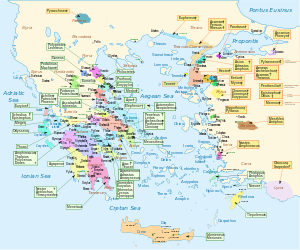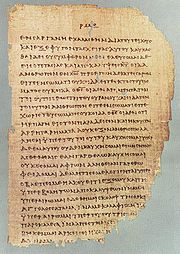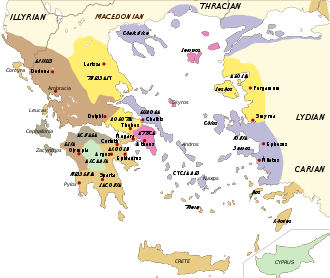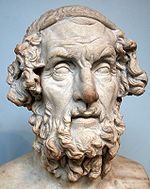- Ancient Greek
-
This article is about the language. For Ancient Greek culture in general, see Ancient Greece. For Ancient Greek population groups, see List of Ancient Greek tribes.
Ancient Greek Ἑλληνική
HellēnikḗSpoken in eastern Mediterranean Extinct developed into Koiné Greek by the 4th century BC Language family Indo-European- Hellenic
- Ancient Greek
Writing system Greek alphabet Language codes ISO 639-2 grc ISO 639-3 grc 
This page contains IPA phonetic symbols in Unicode. Without proper rendering support, you may see question marks, boxes, or other symbols instead of Unicode characters. Ancient Greek is the stage of the Greek language in the periods spanning the times c. 9th–6th centuries BC, (known as Archaic), c. 5th–4th centuries BC (Classical), and the c. 3rd century BC – 6th century AD (Hellenistic) of ancient Greece and the ancient world; being predated in the 2nd millennium BC by Mycenaean Greek. The language of the Hellenistic phase is known as Koine (common) or Biblical Greek, the language from the late period onward has no considerable difference from Medieval Greek. Koine is regarded as a separate historical stage of its own, although in its earlier form it closely resembles the Classical. Prior to the Koine period, Greek of the classic and earlier periods included several regional dialects.
Ancient Greek was the language of Homer and of classical Athenian historians, playwrights, and philosophers. It has contributed many words to English vocabulary and has been a standard subject of study in educational institutions of the West, since the Renaissance. This article's primary concern is the Epic and Classical phases of the language.
Contents
Dialects
The origins, early forms, and early development of the Hellenic language family are not well understood, owing to the lack of contemporaneous evidence. There are several theories about what Hellenic dialect groups may have existed between the divergence of early Greek-like speech from the common Proto-Indo-European language. They have the same general outline but differ in some of the detail. The only attested dialect from this period[1] is Mycenaean, but its relationship to the historical dialects and the historical circumstances of the times imply that the overall groups already existed in some form.
History of the
Greek language
(see also: Greek alphabet)
Proto-Greek (c. 3000–1600 BC) Mycenaean (c. 1600–1100 BC) Ancient Greek (c. 800–330 BC)
Dialects:
Aeolic, Arcadocypriot, Attic-Ionic,
Doric, Locrian, Pamphylian,
Homeric Greek,
Macedonian (?)Koine Greek (c. 330 BC–330) Medieval Greek (330–1453) Modern Greek (from 1453)
Dialects:
Calabrian, Cappadocian, Cheimarriotika, Cretan,
Cypriot, Demotic, Griko, Katharevousa,
Pontic, Tsakonian, Maniot, Yevanic
*Dates (beginning with Ancient Greek) from Wallace, D. B. (1996). Greek Grammar Beyond the Basics: An Exegetical Syntax of the New Testament. Grand Rapids: Zondervan. p. 12. ISBN 0310218950.The major dialect groups of the Ancient Greek period can be assumed to have developed not later than 1120 BC, at the time of the Dorian invasion(s), and their first appearances as precise alphabetic writing began in the 8th century BC. The invasion would not be "Dorian" unless the invaders had some cultural relationship to the historical Dorians; moreover, the invasion is known to have displaced population to the later Attic-Ionic regions, who regarded themselves as descendants of the population displaced by or contending with the Dorians.
The ancient Greeks themselves considered there to be three major divisions of all the other Greek people—Dorians, Aeolians and Ionians (including Athenians), each with their own defining and distinctive dialects. Allowing for their oversight of Arcadian, an obscure mountain dialect, and Cyprian, far from the center of Greek scholarship, this division of people and language is quite similar to the results of modern archaeological-linguistic investigation.
One standard formulation for the dialects is:[2]
 Distribution of Greek dialects in the classical period.[3]
Distribution of Greek dialects in the classical period.[3]
Western group: Central group: Eastern group: Achaean Doric Greek- West Group
- Northwest Greek
- Doric
- Aeolic Group
- Aegean/Asiatic Aeolic
- Thessalian
- Boeotian
- Ionic-Attic Group
- Attica
- Euboea and colonies in Italy
- Cyclades
- Asiatic Ionia
- Arcadocypriot Greek
- Arcadian
- Cypriot
West vs. non-west Greek is the strongest marked and earliest division, with non-west in subsets of Ionic-Attic (or Attic-Ionic) and Aeolic vs. Arcado-Cyprian, or Aeolic and Arcado-Cyprian vs. Ionic-Attic. Often non-west is called East Greek.
The Arcado-Cyprian group apparently descended more closely from the Mycenaean Greek of the Bronze Age.
Boeotian had come under a strong Northwest Greek influence, and can in some respects be considered a transitional dialect. Thessalian likewise had come under Northwest Greek influence, though to a lesser degree.
Pamphylian, spoken in a small area on the south-western coast of Asia Minor and little preserved in inscriptions, may be either a fifth major dialect group, or it is Mycenaean Greek overlaid by Doric, with a non-Greek native influence.
Ancient Macedonian was an Indo-European language closely related to Greek, but its exact relationship is unclear because of insufficient data: possibly a dialect of Greek; a sibling language to Greek; or a close cousin to Greek, and perhaps related to some extent, to Thracian and Phrygian languages. The Pella curse tablet is one of the many clear finds which support the idea that the Ancient Macedonian language is closely related to the Doric Greek dialect.
Most of the dialect sub-groups listed above had further subdivisions, generally equivalent to a city-state and its surrounding territory, or to an island. Doric notably had several intermediate divisions as well, into Island Doric (including Cretan Doric), Southern Peloponnesus Doric (including Laconian, the dialect of Sparta), and Northern Peloponnesus Doric (including Corinthian).
The Lesbian dialect was a member of the Aegean/Asiatic Aeolic sub-group.
All the groups were represented by colonies beyond Greece proper as well, and these colonies generally developed local characteristics, often under the influence of settlers or neighbors speaking different Greek dialects.
The dialects outside the Ionic group are known mainly from inscriptions, notable exceptions being fragments of the works of the poetess Sappho from the island of Lesbos and the poems of the Boeotian poet, Pindar.
After the conquests of Alexander the Great in the late 300's BC, a new international dialect known as Koine or Common Greek developed, largely based on Attic Greek, but with influence from other dialects. This dialect slowly replaced most of the older dialects, although Doric dialect has survived to the present in the form of the Tsakonian dialect of Modern Greek, spoken in the region of modern Sparta. Doric has also passed down its aorist terminations into most verbs of Demotic Greek. By about the 500's AD, the Koine had slowly metamorphosized into Medieval Greek.
Sound changes

Greek alphabet Αα Alpha Νν Nu Ββ Beta Ξξ Xi Γγ Gamma Οο Omicron Δδ Delta Ππ Pi Εε Epsilon Ρρ Rho Ζζ Zeta Σσς Sigma Ηη Eta Ττ Tau Θθ Theta Υυ Upsilon Ιι Iota Φφ Phi Κκ Kappa Χχ Chi Λλ Lambda Ψψ Psi Μμ Mu Ωω Omega History Archaic local variants
 ·
·  ·
·  ·
·  ·
·  ·
· 
Ligatures (ϛ, ȣ, ϗ) · Diacritics Numerals:  (6) ·
(6) ·  (90) ·
(90) ·  (900)
(900)In other languages Bactrian · Coptic · Albanian Scientific symbols
 Book ·
Book ·  Category ·
Category ·  Commons
Commons
Main article: Proto-GreekSee Proto-Greek for a description of sound changes from Proto-Indo-European up through attested Ancient Greek.
Phonology
The pronunciation of Post-Classic Greek changed considerably from Ancient Greek, although the orthography still reflects features of the older language (see W. Sidney Allen, Vox Graeca – a guide to the pronunciation of Classical Greek). For a detailed description on the phonology changes from Ancient to Hellenistic periods of the Greek language, see the article on Koine Greek.
The examples below are intended to represent Attic Greek in the 5th century BC. Although ancient pronunciation can never be reconstructed with certainty, Greek in particular is very well documented from this period, and there is little disagreement among linguists as to the general nature of the sounds that the letters represented.
Vowels
Front Back unrounded rounded Close i iː y yː Close-mid e eː o oː Open-mid ɛː ɔː Open a aː /oː/ raised to [uː], probably by the 4th century BC.
Certain vowels historically underwent compensatory lengthening in certain contexts. /a/ sometimes lengthened to [aː] or [ɛː], and /e/ and /o/ become the closed values [eː] and [oː] and the open ones [ɛː] and [ɔː] depending on time period.
Consonants
Bilabial Dental Velar Glottal Nasal m n (ŋ) Plosive voiced b d ɡ voiceless p t k aspirated pʰ tʰ kʰ Fricative s h Trill r Lateral l [ŋ] occurred as an allophone of /n/ used before velars and as an allophone of /ɡ/ before nasals. /r/ was probably voiceless when word-initial (written ῥ)
Assimilation
In verb conjugation, one consonant often comes up against the other. Various sandhi rules apply.
Rules:
- Most basic rule: When two sounds appear next to each other, the first assimilates in voicing and aspiration to the second.
- This applies fully to stops. Fricatives assimilate only in voicing, sonorants do not assimilate.
- Before an /s/ (future, aorist stem), velars become [k], labials become [p], and dentals disappear.
- Before a /tʰ/ (aorist passive stem), velars become [kʰ], labials become [pʰ], and dentals become [s].
- Before an /m/ (perfect middle first-singular, first-plural, participle), velars become [ɡ], nasal+velar becomes [ɡ], labials become [m], dentals become [s], other sonorants remain the same.
Morphology
Greek, like all of the older Indo-European languages, is highly inflected. It is highly archaic in its preservation of Proto-Indo-European forms. In Ancient Greek nouns (including proper nouns) have five cases (nominative, genitive, dative, accusative and vocative), three genders (masculine, feminine and neuter), and three numbers (singular, dual and plural). Verbs have four moods (indicative, imperative, subjunctive, and optative), three voices (active, middle and passive), as well as three persons (first, second and third) and various other forms. Verbs are conjugated through seven combinations of tenses and aspect (generally simply called "tenses"): the present, future and imperfect are imperfective in aspect; the aorist (perfective aspect); a present perfect, pluperfect and future perfect. Most tenses display all four moods and three voices, although there is no future subjunctive or imperative. Also, there is no imperfect subjunctive, optative or imperative. There are infinitives and participles corresponding to the finite combinations of tense, aspect and voice.
Augment
The indicative of past tenses adds (conceptually, at least) a prefix /e-/. This was probably originally a separate word, meaning something like "then", added because tenses in PIE had primarily aspectual meaning. The augment is added to the indicative of the aorist, imperfect and pluperfect, but not to any of the other forms of the aorist (no other forms of the imperfect and pluperfect exist).
There are two kinds of augment in Greek, syllabic and quantitative. The syllabic augment is added to stems beginning with consonants, and simply prefixes e (stems beginning with r, however, add er). The quantitative augment is added to stems beginning with vowels, and involves lengthening the vowel:
- a, ā, e, ē → ē
- i, ī → ī
- o, ō → ō
- u, ū → ū
- ai → ēi
- ei → ēi or ei
- oi → ōi
- au → ēu or au
- eu → ēu or eu
- ou → ou
Some verbs augment irregularly; the most common variation is e → ei. The irregularity can be explained diachronically by the loss of s between vowels. In verbs with a prefix, the augment is placed not at the start of the word, but between the prefix and the original verb. For example, προσ(-)βάλλω (I attack) goes to προσέβαλoν in the aorist.
Following Homer's practice, the augment is sometimes not made in poetry, especially epic poetry.
The augment sometimes substitutes for reduplication; see below.
Reduplication
Almost all forms of the perfect, pluperfect and future perfect reduplicate the initial syllable of the verb stem. (Note that a few irregular forms of perfect do not reduplicate, whereas a handful of irregular aorists reduplicate.) There are three types of reduplication:
- Syllabic reduplication: Most verbs beginning with a single consonant, or a cluster of a stop with a sonorant, add a syllable consisting of the initial consonant followed by e. An aspirated consonant, however, reduplicates in its unaspirated equivalent: Grassmann's law.
- Augment: Verbs beginning with a vowel, as well as those beginning with a cluster other than those indicated previously (and occasionally for a few other verbs) reduplicate in the same fashion as the augment. This remains in all forms of the perfect, not just the indicative.
- Attic reduplication: Some verbs beginning with an a, e or o, followed by a sonorant (or occasionally d or g), reduplicate by adding a syllable consisting of the initial vowel and following consonant, and lengthening the following vowel. Hence er → erēr, an → anēn, ol → olōl, ed → edēd. This is not actually specific to Attic Greek, despite its name; but it was generalized in Attic. This originally involved reduplicating a cluster consisting of a laryngeal and sonorant; hence h₃l → h₃leh₃l → olōl with normal Greek development of laryngeals. (Forms with a stop were analogous.)
Irregular duplication can be understood diachronically. For example, lambanō (root lab) has the perfect stem eilēpha (not *lelēpha) because it was originally slambanō, with perfect seslēpha, becoming eilēpha through (semi-)regular change.
Reduplication is also visible in the present tense stems of certain verbs. These stems add a syllable consisting of the root's initial consonant followed by i. A nasal consonant appears after the reduplication in some verbs.[4]
Writing system
Ancient Greek was written in the Greek alphabet, with some variation among dialects. Early texts are written in boustrophedon style, but left-to-right became standard during the classic period. Modern editions of Ancient Greek texts are usually written with accents and breathing marks, interword spacing, modern punctuation, and sometimes mixed case, but these were all introduced later.
Example text
The following polytonic Greek text is from the beginning of Apology by Plato:
- Ὅτι μὲν ὑμεῖς, ὦ ἄνδρες Άθηναῖοι, πεπόνθατε ὑπὸ τῶν ἐμῶν κατηγόρων, οὐκ οἶδα: ἐγὼ δ' οὖν καὶ αὐτὸς ὑπ' αὐτῶν ὀλίγου ἐμαυτοῦ ἐπελαθόμην, οὕτω πιθανῶς ἔλεγον. Καίτοι ἀληθές γε ὡς ἔπος εἰπεῖν οὐδὲν εἰρήκασιν.
Transliterated into the Latin alphabet using a modern version of the Erasmian scheme:
- Hóti mèn humeîs, ô ándres Athēnaîoi, pepónthate hupò tôn emôn katēgórōn, ouk oîda: egṑ d' oûn kaì autòs hup' autōn olígou emautoû epelathómēn, hoútō pithanôs élegon. Kaítoi alēthés ge hōs épos eipeîn oudèn eirḗkasin.
Translated into English:
- What you, men of Athens, have learned from my accusers, I do not know: but I, for my part, nearly forgot who I was thanks to them, since they spoke so persuasively. And yet, of the truth, they have spoken, one might say, nothing at all.
Another example, from the beginning of Homer's Iliad:
Μῆνιν ἄειδε, θεά, Πηληιάδεω Ἀχιλῆος
οὐλομένην, ἣ μυρί’ Ἀχαιοῖς ἄλγε’ ἔθηκε,
πολλὰς δ’ ἰφθίμους ψυχὰς Ἄϊδι προΐαψεν
ἡρώων, αὐτοὺς δὲ ἑλώρια τεῦχε κύνεσσιν
οἰωνοῖσί τε πᾶσι· Διὸς δ’ ἐτελείετο βουλή·
ἐξ οὗ δὴ τὰ πρῶτα διαστήτην ἐρίσαντε
Ἀτρεΐδης τε ἄναξ ἀνδρῶν καὶ δῖος Ἀχιλλεύς.Modern use
The study of Ancient Greek in European countries in addition to Latin occupied an important place in the syllabus from the Renaissance until the beginning of the 20th century. Ancient Greek is still taught as a compulsory or optional subject especially at traditional or elite schools throughout Europe, such as public schools and grammar schools in the United Kingdom. It is compulsory in the Liceo classico in Italy, in the gymnasium in the Netherlands, in some classes in Austria, in Croatia in klasicna gimnazija and it is optional in the Humanistisches Gymnasium in Germany (usually as a third language after Latin and English, from the age of 14 to 18). In 2006/07, 15,000 pupils studied Ancient Greek in Germany according to the Federal Statistical Office of Germany, and 280,000 pupils studied it in Italy.[5] Ancient Greek is also taught at most major universities worldwide, often combined with Latin as part of Classics. It will also be taught in state primary schools in the UK, to boost children’s language skills.[6][7][8] Ancient Greek is also taught as a compulsory subject in Gymnasia and Lycia in Greece.[9][10]
Ancient Greek is often used in the coinage of modern technical terms in the European languages: see English words of Greek origin.
Modern authors rarely write in Ancient Greek, though Jan Křesadlo wrote some poetry and prose in the language, and some volumes of Asterix have been written in Attic Greek[11] and Harry Potter and the Philosopher's Stone has been translated into Ancient Greek.[12]
Ancient Greek is also used by organizations and individuals, mainly Greek, who wish to denote their respect, admiration or preference for the use of this language. This use is sometimes considered graphical, nationalistic or funny. In any case, the fact that modern Greeks can still wholly or partly understand texts written in non-archaic forms of ancient Greek shows the affinity of modern Greek language to its ancestral predecessor.[13]
An isolated community near Trabzon, Turkey, an area where Pontic Greek is spoken, has been found to speak a variety of Greek that has parallels, both structurally and in its vocabulary, to Ancient Greek not present in other varieties.[14] As few as 5,000 people speak the dialect but linguists believe that it is the closest living language to Ancient Greek.[15][16]
Latinized forms of Ancient Greek roots are used in many of the scientific names of species and in scientific terminology.
See also
- Exploring the Ancient Greek Language and Culture (competition)
- Greek alphabet
- Greek declension
- Greek diacritics
- Mycenaean Greek language
- Koine Greek
- Medieval Greek
- Modern Greek
- Greek language
- List of Greek phrases (mostly Ancient Greek)
References
- ^ Imprecisely attested and somewhat reconstructive due to its being written in an ill-fitting syllabary (Linear B).
- ^ This one is to be found in recent versions of the Encyclopedia Britannica, which also lists the major works defining the subject.[page needed]
- ^ Roger D. Woodard (2008), "Greek dialects", in: The Ancient Languages of Europe, ed. R. D. Woodard, Cambridge: Cambridge University Press, p. 51.
- ^ Palmer, Leonard (1996). The Greek Language. Norman, OK: University of Oklahoma Press. pp. 262. ISBN 0806128445.
- ^ [1]
- ^ Ancient Greek 'to be taught in state schools'
- ^ "Primaries go Greek to help teach English" - Education News - 30 July 2010.
- ^ "Now look, Latin's fine, but Greek might be even Beta" TES Editorial © 2010 - TSL Education Ltd.
- ^ http://www.fa3.gr/phys_educ_2/33-orologio-programma-Gymnasiou.htm
- ^ http://edu.klimaka.gr/leitoyrgia-sxoleivn/lykeio/755-wrologio-programma-genika-lykeia.html
- ^ Asterix speaks Attic (classical Greek) - Greece (ancient)
- ^ Areios Potēr kai ē tu philosophu lithos, Bloomsbury 2004, ISBN 1-58234-826-X
- ^ Akropolis World News, and Tech news in Ancient Greek
- ^ Jason and the argot: land where Greek's ancient language survives, The Independent, 3 January 2011
- ^ Against all odds: archaic Greek in a modern world, University of Cambridge
- ^ Archaic Greek in a modern world video from Cambridge University, on You Tube
Further reading
- P. Chantraine (1968), Dictionnaire étymologique de la langue grecque, Klincksieck, Paris.
- Athenaze A series of textbooks on Ancient Greek published for school use
- Hansen, Hardy and Quinn, Gerald M. (1992) Greek: An Intensive Course, Fordham University Press
External links
- Ancient Greek Swadesh list of basic vocabulary words (from Wiktionary's Swadesh list appendix)
Grammar learning
- A more extensive grammar of the Ancient Greek language written by J. Rietveld
- Recitation of classics books
- Ancient Greek Language Teaching Podcast
- Perseus Greek dictionaries
- Greek-Language.com Information on the history of the Greek language, application of modern Linguistics to the study of Greek, and tools for learning Greek
- Free Lessons in Ancient Greek, Bilingual Libraries, Forum
- Ancient Greek Tutorials Berkeley Language Center of the University of California
- New Testament Greek
- Acropolis World News A summary of the latest world news in Ancient Greek, Juan Coderch, University of St Andrews
Classical texts
Greek language · Eλληνική γλώσσα History Proto-Greek (c. 3000–1600 BC) · Mycenaean (c. 1600–1000 BC) · Ancient Greek (c. 1000–330 BC) · Koine Greek (c. 330 BC–330) · Medieval Greek (330–1453) · Modern Greek (from 1453)
Alphabet Letters Phonology Grammar Dialects Cappadocian · Cretan · Cypriot · Chalkidiki · Demotic · Greek-Calabrian · Griko · Katharevousa · Macedonian · Misthiotica · Pontic · Tsakonian · YevanicLiterature Related Topics Promotion and Study Ages of Greek c. 3rd millenium BC c. 1600–1100 BC c. 800–300 BC c. 300 BC – AD 330 c. 330–1453 since 1453 Ancient Greek
Categories:- Ancient Greek language
- Varieties of Greek
- Ancient languages
- Ancient Greece
- Hellenic
Wikimedia Foundation. 2010.

